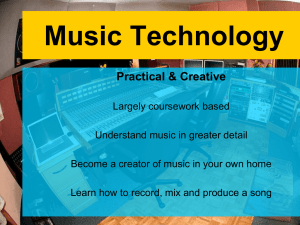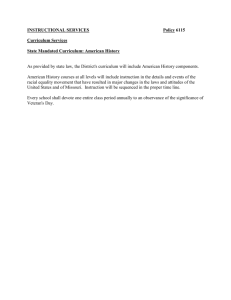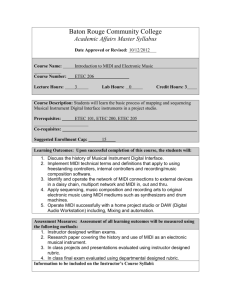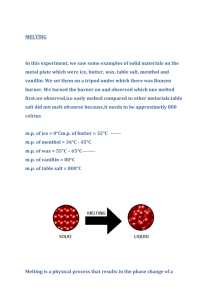AS/A2 Sequenced Arrangement Task
advertisement
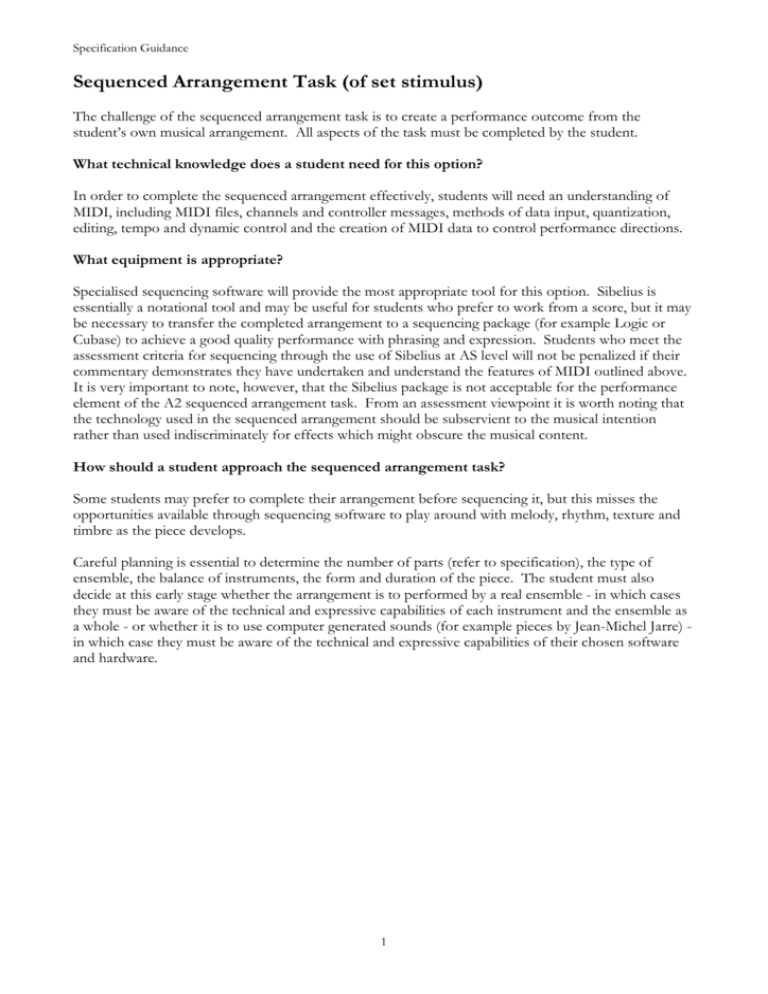
Specification Guidance Sequenced Arrangement Task (of set stimulus) The challenge of the sequenced arrangement task is to create a performance outcome from the student’s own musical arrangement. All aspects of the task must be completed by the student. What technical knowledge does a student need for this option? In order to complete the sequenced arrangement effectively, students will need an understanding of MIDI, including MIDI files, channels and controller messages, methods of data input, quantization, editing, tempo and dynamic control and the creation of MIDI data to control performance directions. What equipment is appropriate? Specialised sequencing software will provide the most appropriate tool for this option. Sibelius is essentially a notational tool and may be useful for students who prefer to work from a score, but it may be necessary to transfer the completed arrangement to a sequencing package (for example Logic or Cubase) to achieve a good quality performance with phrasing and expression. Students who meet the assessment criteria for sequencing through the use of Sibelius at AS level will not be penalized if their commentary demonstrates they have undertaken and understand the features of MIDI outlined above. It is very important to note, however, that the Sibelius package is not acceptable for the performance element of the A2 sequenced arrangement task. From an assessment viewpoint it is worth noting that the technology used in the sequenced arrangement should be subservient to the musical intention rather than used indiscriminately for effects which might obscure the musical content. How should a student approach the sequenced arrangement task? Some students may prefer to complete their arrangement before sequencing it, but this misses the opportunities available through sequencing software to play around with melody, rhythm, texture and timbre as the piece develops. Careful planning is essential to determine the number of parts (refer to specification), the type of ensemble, the balance of instruments, the form and duration of the piece. The student must also decide at this early stage whether the arrangement is to performed by a real ensemble - in which cases they must be aware of the technical and expressive capabilities of each instrument and the ensemble as a whole - or whether it is to use computer generated sounds (for example pieces by Jean-Michel Jarre) in which case they must be aware of the technical and expressive capabilities of their chosen software and hardware. 1 Specification Guidance What about editing? During the editing process students should be encouraged to pay particular attention to aspects such as: tempo (to take account of subtle shifts in tempo including accelerando, rallentando etc. and aspects of rubato); articulation (where appropriate, sensitive repositioning of note on/note off values); phrasing and dynamics (combining velocity and volume to achieve expression); panning (to reflect the positioning of players in an authentic performance or for special effects); program changes (to take account of subtle changes in instrumental timbre, for example, arco to pizzicato strings); reverb and chorus (to create ambience and a denser texture); quantization (musically sensitive use of this facility to avoid mechanical reproduction); pitch bend (a feature of much modern music, especially jazz and blues idioms which can be used to add authentic effects to individual parts); modulation (also applied to instrumental parts where it would be considered appropriate in live performance); and portamento (most appropriate for modern music or music with rich chromatic harmony). Teachers are advised to listen to students’ work at various stages of development so the student receives feedback at regular intervals. A statement of authenticity must also be signed by the teacher before it is submitted for assessment. It is also a good idea for students to keep recordings or software files of each milestone in the development of their piece as a back-up in case something goes wrong or gets lost. Students should aim to finish their work a good three weeks before it is due for assessment to allow for the finishing touches. Finishing touches Sequenced arrangement tasks must be submitted as recorded performances on CD, MiniDisc or audio file, in other words, one that can be played on any standard CD player or MiniDisc player. The student’s work must also be submitted as a standard MIDI file on a separate CD. Each CD/MD should be clearly labelled with: Centre Number Candidate Number Year of entry MIDI File or Audio Recording Work submitted without an audio recording will be returned to the centre unmarked! 2 Specification Guidance Commentary The purpose of the commentary is to guide the listener to points of interest, not bore them with a barby-bar analysis. Examiners are more interested in the creative and technical processes so students are encouraged to describe how they started; who or what influenced them and how the piece developed. Students should draw the listener’s attention to points of musical interest, especially the use of musical devices. They should use detailed technical language when appropriate to show understanding but not re-type the software manual! Finally Teachers and students are encouraged to refer to the assessment criteria at all stages in the sequenced arrangement task. 3
